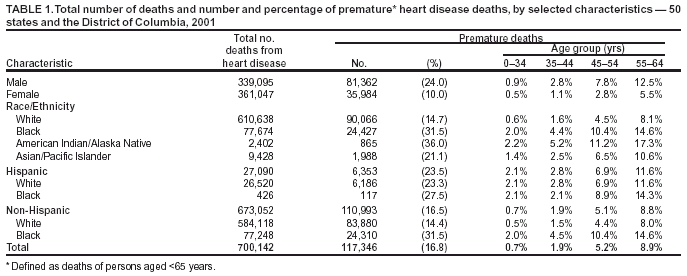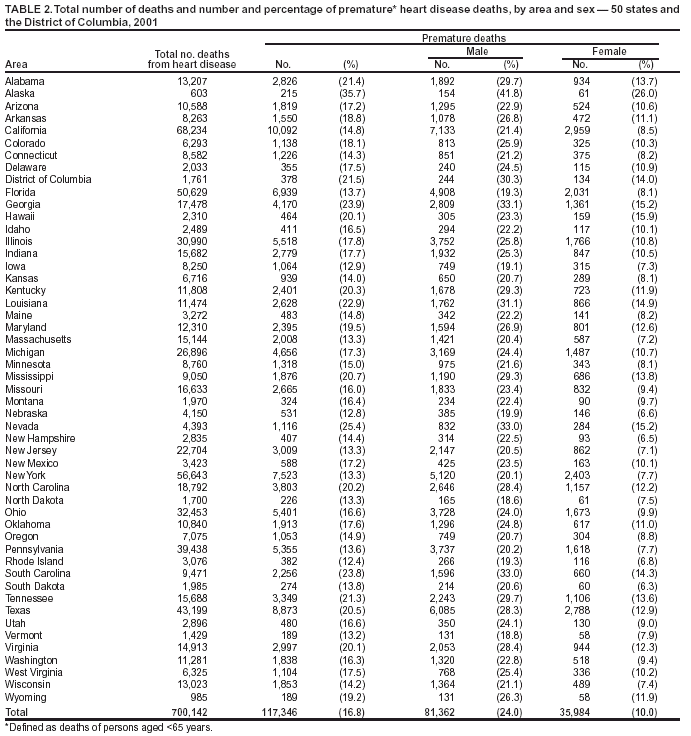 |
|
|
|
|
|
|
| ||||||||||
|
|
|
|
|
|
|
||||
| ||||||||||
|
|
|
|
|
Persons using assistive technology might not be able to fully access information in this file. For assistance, please send e-mail to: mmwrq@cdc.gov. Type 508 Accommodation and the title of the report in the subject line of e-mail. Disparities in Premature Deaths from Heart Disease --- 50 States and the District of Columbia, 2001In 2001, heart disease accounted for approximately 29.0% of deaths among U.S. residents; 16.8% of those deaths occurred among persons aged <65 years (1). Although mortality rates from heart disease have decreased, the decline has not been uniform for all populations (2). One of the two overall national health objectives for 2010 is to eliminate health disparities among different segments of the U.S. population (3). To better understand these disparities, CDC analyzed death certificate data for premature deaths from heart disease occurring in 2001. This report summarizes the results of that analysis, which indicated that the proportion of premature heart disease deaths varied by state and was higher among blacks, American Indians/Alaska Natives (AI/ANs), Asians/Pacific Islanders (A/PIs), and Hispanics. Reducing premature death from heart disease and eliminating disparities will require preventing, detecting, treating, and controlling risk factors for heart disease in young and middle-aged adults. Death certificate data from the 50 states and the District of Columbia (DC) were obtained from the National Center for Health Statistics. Demographic data (e.g., age and race/ethnicity) on death certificates were reported by funeral directors or provided by family members. Heart disease--related deaths were defined as those for which the underlying causes listed on death certificates by a physician or coroner were International Classification of Diseases, Tenth Revision (ICD-10), codes I00--I09, I11, I13, or I20--I51. Premature deaths were defined as those occurring among persons aged <65 years. Proportions of premature death were calculated for all 50 states and DC. During 2001, of 700,142 deaths attributed to heart disease, 117,346 (16.8%) occurred among persons aged <65 years. The proportion of premature deaths was greatest among AI/ANs (36.0%) and blacks (31.5%) and lowest among whites (14.7%) (Table 1). Premature death was higher for Hispanics (23.5%) than non-Hispanics (16.5%), and for males (24.0%) than females (10.0%). Hispanic whites (23.3%) had lower proportions than Hispanic blacks (27.5%), and non-Hispanic whites had lower proportions (14.4%) than non-Hispanic blacks (31.5%). The highest proportions of all deaths occurred among persons aged 55--64 years. When premature death was examined by age-specific death rate, mortality increased with age, and rates across all age groups were highest among blacks and lowest among A/PIs (Figure). The proportions of premature heart disease deaths ranged from 12.4% in Rhode Island to 35.7% in Alaska (Table 2). The 10 areas with the highest proportions were Alaska (35.7%), Nevada (25.4%), Georgia (23.9%), South Carolina (23.8%), Louisiana (22.9%), DC (21.5%), Alabama (21.4%), Tennessee (21.3%), Mississippi (20.7%), and Texas (20.5%). Among males, proportions were highest in Alaska (41.8%) and lowest in North Dakota (18.6%); among females, proportions were highest in Alaska (26.0%) and lowest in South Dakota (6.3%). Within states/areas, racial/ethnic differences in premature death were similar to those observed overall. Reported by: SS Oh, MPH, JB Croft, PhD, KJ Greenlund, PhD, C Ayala, PhD, ZJ Zheng, MD, GA Mensah, MD, WH Giles, MD, Div of Adult and Community Health, National Center for Chronic Disease Prevention and Health Promotion, CDC. Editorial Note:In 2001, approximately 17% of all deaths from heart disease occurred among persons aged <65 years; these deaths occurred disproportionately among certain racial/ethnic minority populations, and demographic and geographic disparities also persisted. The determinants of these disparities are not clear. Differences by sex might be attributed in part to the cardioprotective effects of estrogen in pre- and perimenopausal women (4). Specific racial/ethnic variations might reflect differences in demographics, risk factors for heart disease, access to medical and emergency care, or other factors. For example, in the United States, the prevalence of obesity and diabetes is higher for blacks and AI/ANs than whites (5). The prevalence of cigarette smoking for AI/ANs is nearly double that for whites (5). Blacks have a higher prevalence of high blood pressure than whites (5--7), and Hispanics are less likely than whites to have their blood pressure checked (6), to be aware of having high blood pressure (7), or to be treated and controlled for high blood pressure (7). In the United States, greater proportions of blacks, Hispanics, and AI/ANs than whites lack health-care coverage and cite cost as a barrier to obtaining health care (5). State variations probably reflect differences in demographics, lifestyles, and risk factors. Among the 10 areas with the highest proportions of premature death, those in the southeast also have high prevalence of high blood pressure (6), smoking, physical inactivity, and obesity (8). These risk factors are not as prevalent in DC and Hawaii, which suggests that other risk factors (e.g., dietary factors and elevated serum cholesterol) might be more dominant causes of premature death in those areas. The findings in this report are subject to at least two limitations. First, underlying cause of death data are subject to errors in the certification of cause of death. Second, racial/ethnic populations have different proportions of persons at younger ages (9), which might account for the different proportions of premature deaths. In 2001, approximately 86% of non-Hispanic whites were aged <65 years, compared with 92% of non-Hispanic blacks, 94% of AI/ANs, 92% of A/PIs, and 95% of Hispanics (1). Although death rates vary by race/ethnicity, heart disease is the leading cause of death for all racial/ethnic minority populations except A/PIs, for which it is the second leading cause of death (9). Risk factors for heart disease include high blood pressure, elevated serum cholesterol levels, smoking, diabetes, physical inactivity, and obesity. Premature death from heart disease can be reduced by preventing or treating these risk factors. Public health professionals should focus efforts on prevention and risk reduction at all ages, and particularly at younger ages among racial/ethnic minorities. Further analysis of state data should be conducted to identify county-level disparities, which might aid public health agencies in allocating resources more effectively. The proportion of deaths among persons aged <65 years and the high prevalence of the major risk factors in the general population underscore the need for aggressive public health efforts. Improved health promotion and primary and secondary prevention strategies are needed to decrease the burden of heart disease and eliminate health disparities in the population. References
Table 1  Return to top. Table 2  Return to top. Figure  Return to top.
Disclaimer All MMWR HTML versions of articles are electronic conversions from ASCII text into HTML. This conversion may have resulted in character translation or format errors in the HTML version. Users should not rely on this HTML document, but are referred to the electronic PDF version and/or the original MMWR paper copy for the official text, figures, and tables. An original paper copy of this issue can be obtained from the Superintendent of Documents, U.S. Government Printing Office (GPO), Washington, DC 20402-9371; telephone: (202) 512-1800. Contact GPO for current prices. **Questions or messages regarding errors in formatting should be addressed to mmwrq@cdc.gov.Page converted: 2/19/2004 |
|||||||||
This page last reviewed 2/19/2004
|